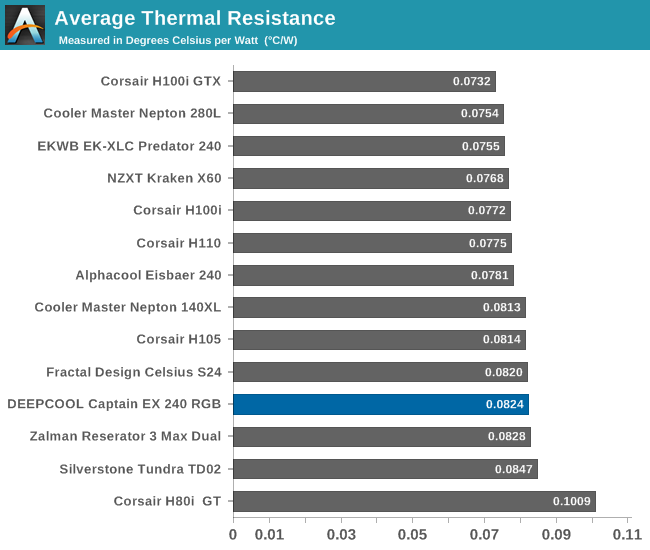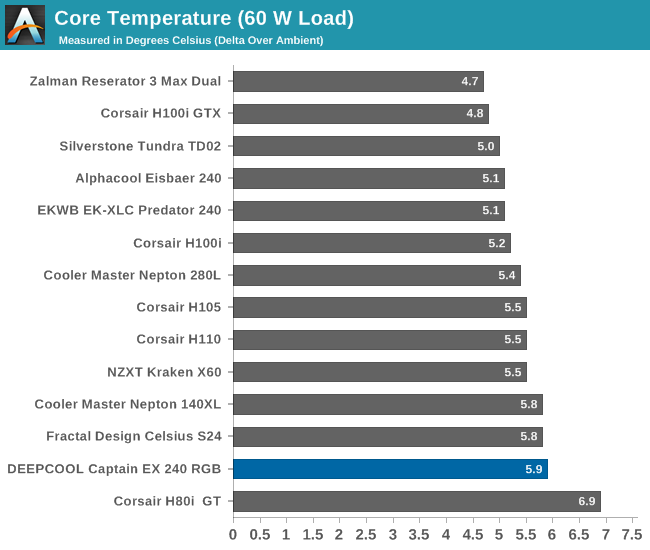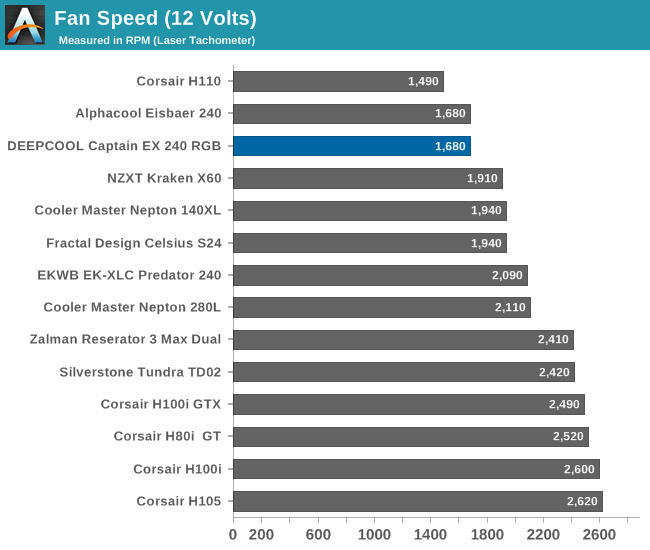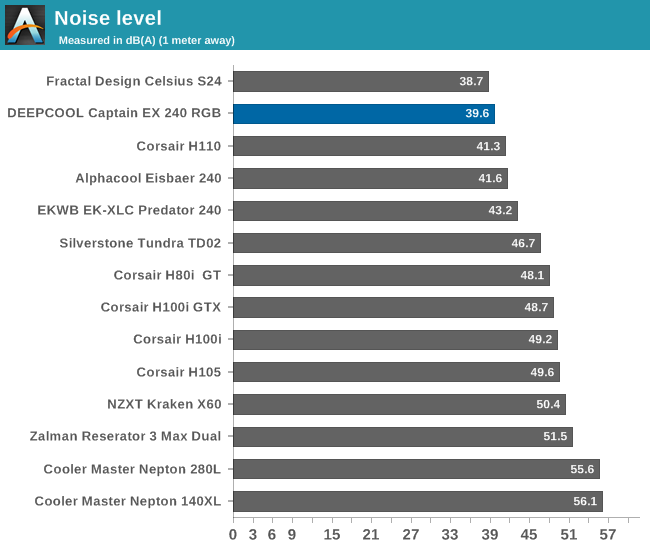The DeepCool Captain 240 EX RGB AIO Cooler Review: Pump it Up, Without the Noise
by E. Fylladitakis on December 14, 2017 9:00 AM EST- Posted in
- Cases/Cooling/PSUs
- AIO
- Deepcool
- Cooler
Testing Results, Maximum Fan Speed
Our maximum speed testing is performed with both the fans and the pump of the kit powered via a 12V DC source. At this voltage, the speed of the pump and the fans should match the manufacturer’s ratings. DEEPCOOL specifies that the TF120 fans have a maximum speed of 1800±10% RPM. Our tachometer indicated a speed of 1680 RPM, which is a bit on the low side but still fully inside the manufacturer’s specifications.

Our testing of the DEEPCOOL Captain EX 240 RGB was unsurprising, with the cooler’s thermal performance being very similar to that of most other equally sized AIO coolers. With the fans running at their maximum speed, the Captain EX 240 RGB has an average thermal resistance of 0.0824 °C/W, placing it higher than most dual 120 mm fan coolers. The average thermal performance of the Captain EX 240 RGB falls right in between the Zalman Reserator 3 Max Dual and the Fractal Design Celsius S24.

| Core Temperature, Constant Thermal Load (Max Fan Speed) |
Although the Captain EX 240 RGB does not land on top of our thermal performance charts, the acoustics performance of the cooler tells an entirely different story. Apparently, DEEPCOOL’s unique fans were not really meant to improve the thermal performance of the cooler but to significantly reduce its noise output instead. The maximum noise output of the Captain EX 240 RGB was 39.6 dB(A), which is second only to that of the Fractal Design Celsius S24.












34 Comments
View All Comments
Galid - Thursday, December 14, 2017 - link
By the time you whined about how things should be done, I had two pages opened, I can tell you this: you get lower noise on air coolers in most scenario but delta over ambient on the worst AIO is lower than the best air cooler at 150w load.I would have loved it if there was two relevant air coolers included in these graphs but nothing to write a page about.
bananaforscale - Wednesday, June 20, 2018 - link
You are asking for apples to apples comparisons on coolers with requirements *that aren't the same* (packaging is a huge deal), therefore your logic breaks down.kevbev89 - Thursday, December 14, 2017 - link
I agree with what tricomp and rtfmx9 said... the "apples to apples" reasoning doesn't apply here. From personal experience a ton of people are always asking is water cooling better than air. From a functional standpoint they both serve the same exact purpose.jabber - Thursday, December 14, 2017 - link
I buy AIO coolers mainly because I don't care about getting max cooling efficiency and I think AIO coolers just look far far better than chunks of chrome plated tin in my rig. I'm sure I'm not the only one.Yuriman - Friday, December 15, 2017 - link
I'm sure you're not. I personally have a side panel on my case and can't see the cooler, so effectiveness and price (value) are the factors important to me.SilthDraeth - Thursday, December 14, 2017 - link
I am so glad that you are here to tell your audience that they are wrong and they don't actually want the products compared, despite the numerous comments suggesting and requesting a direct comparison. You must work for Apple. Even though we all ask for the comparison, and believe that they are competing with each other (after all, they serve the same purpose, cooling your system, so I fail to see how you can't correlate that they would be competing for our dollars), yet, we should just forget our own thoughts, and jump on your bandwagon of no need to compare in the review because they are entirely different types of cooling...Then you finish it off with your condescending "the magic of our professional equipment" line, and "you can easily go look up previous reviews the the information you want" attitude. You are the one being payed to write these reviews. Yes a ton of use have used the past data to find things, but it isn't always so clear cut, if you can't remember an exact model name, or as has happened, the data isn't on the site anymore, or is a bear to find.
Seriously, in the past, I remember they used to have a drop down menu with all the reviewed GPU, or CPU and it was easy to find the information. I don't see that anymore, since the site got redesigned.
So get off your high horse, and lose the snarky attitude. I swear, since Purch bought Anandtech the quality and the attitude has stunk.
SilthDraeth - Thursday, December 14, 2017 - link
Ok, I found the the area I was referencing. "Bench" at the top of the site and yes, the cooling data is in there. Though, I would hope the methodology has remained constant.DanNeely - Thursday, December 14, 2017 - link
It probably is. For other tests when methodology changes the benchmark name changes; which is why you've got things like "GPU 2017".PeachNCream - Thursday, December 14, 2017 - link
Air coolers and liquid coolers absolutely are direct competition with one another and I think it's incorrect to state that they're not. It'd be helpful to a number of readers to include a couple of air coolers (maybe the OEM sorts to form a baseline and one or two aftermarket models) without telling your readers to go fish in old articles. :(normadize - Friday, December 15, 2017 - link
A rather disappointing comment, especially coming from AT. You claim testing is repetitive and that we can look at (much) older reviews and trust the numbers are comparable.While you are not exactly an engineer, you could document yourselves a little better. The ambient temperature could not have been exactly the same. You persist in showing delta above ambient in all your reviews, which is an incredibly misleading figure for anyone without an engineering background: temperature does not have a linear dependency with the causing factors (e.g. power draw increases quadratically with frequency, etc) and the same goes for ambient temperature. Heat up your room by 20C and then run the exact same tests and you'll see different delta-over-ambient figures.
You should stop showing delta-over-ambient and instead include ambient temp and device temp in each of your graph. That's far more informative.